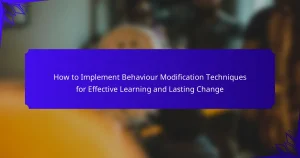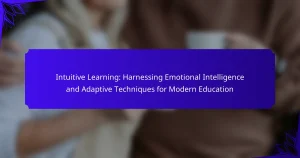Behavior modification techniques are essential for fostering learning, adaptation, and personal growth. This article explores reinforcement, punishment, and modeling as effective strategies. It examines key attributes that enhance these techniques, unique strategies for improved outcomes, and the evolving landscape of personalized and technology-driven approaches. Understanding these elements can lead to significant behaviour change and overall well-being.
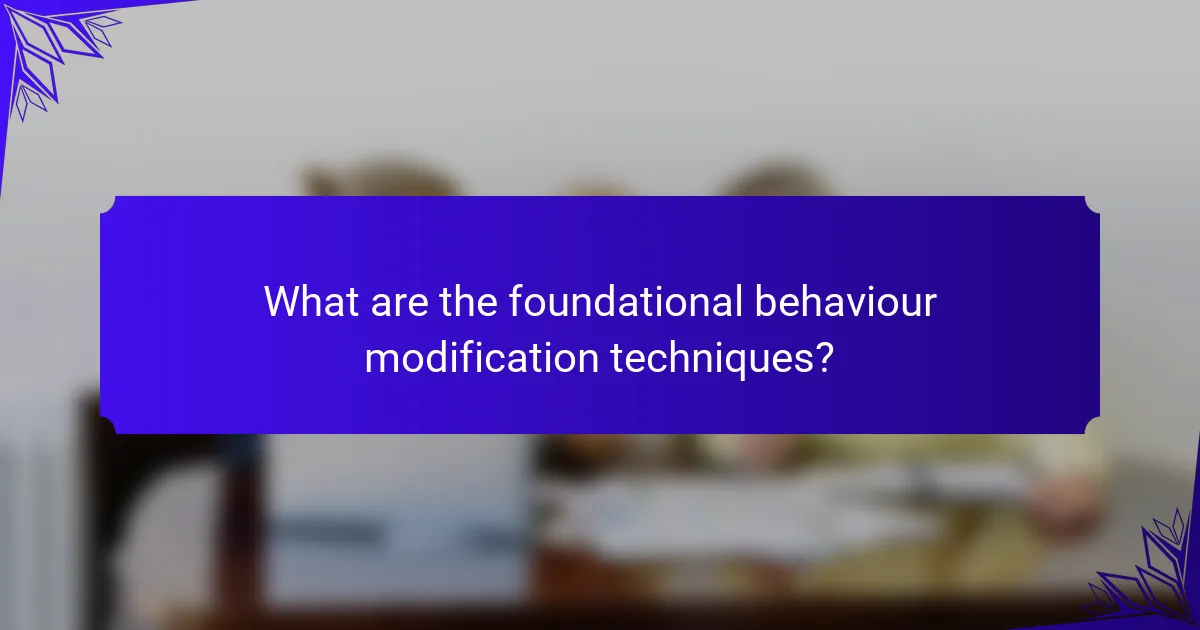
What are the foundational behaviour modification techniques?
Behaviour modification techniques include reinforcement, punishment, and modeling. These strategies foster learning, adaptation, and personal growth effectively. Reinforcement encourages desired behaviours through rewards, while punishment discourages unwanted behaviours. Modeling involves learning through observation, enhancing skills via imitation of others. Each technique has unique applications, impacting behaviour change significantly.
How do reinforcement and punishment shape behaviour?
Reinforcement increases desired behaviour, while punishment decreases unwanted behaviour. Both are essential in behaviour modification techniques for effective learning and personal growth. Reinforcement can be positive, such as rewards, or negative, like the removal of an aversive stimulus. Punishment can also be positive, introducing adverse consequences, or negative, removing pleasant stimuli. Understanding these dynamics helps tailor strategies for individual adaptation and improvement.
What role does classical conditioning play in behaviour modification?
Classical conditioning plays a crucial role in behaviour modification by creating associations between stimuli and responses. This technique helps individuals learn new behaviours or adapt existing ones through repeated pairings of a neutral stimulus with an unconditioned stimulus. For example, a person may learn to associate a specific sound with a positive outcome, leading to a desired behaviour change. The effectiveness of classical conditioning in behaviour modification lies in its ability to reinforce learning through repetition and emotional connections.
How can operant conditioning be applied in everyday life?
Operant conditioning can be effectively applied in everyday life through reinforcement and punishment strategies. Positive reinforcement encourages desired behaviours by providing rewards, while negative reinforcement removes unpleasant stimuli to promote action. For instance, praising a child for completing homework reinforces that behaviour. Similarly, setting consequences for undesirable actions can deter them. Consistency in applying these principles enhances their effectiveness, fostering better habits and personal growth.
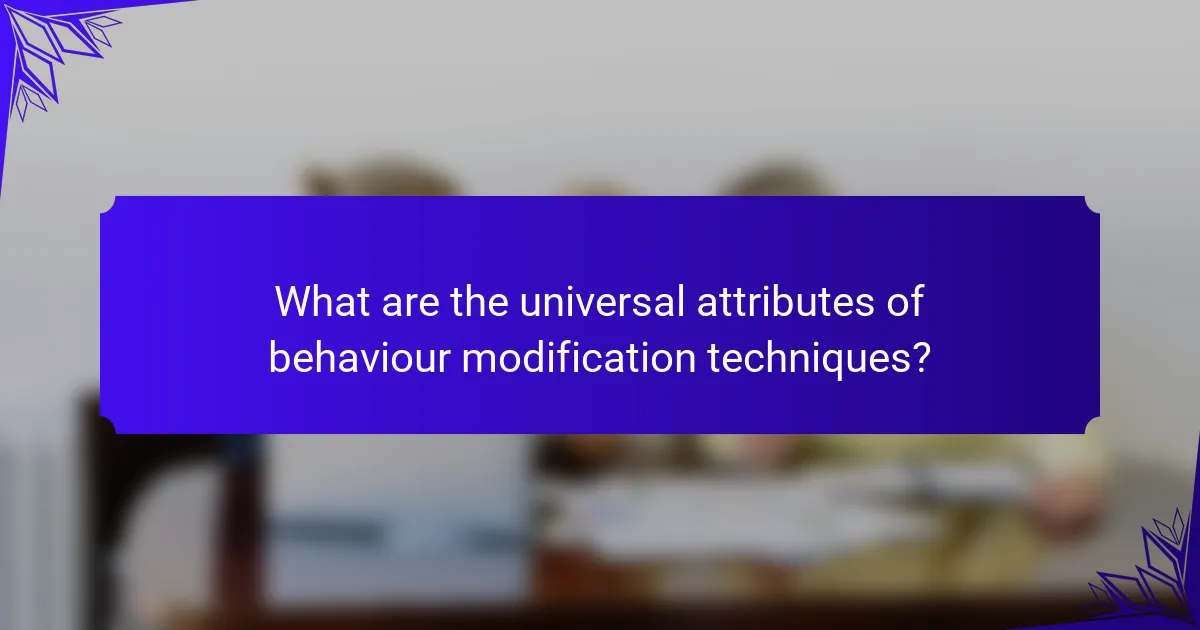
What are the universal attributes of behaviour modification techniques?
Behaviour modification techniques universally share key attributes that enhance learning and personal growth. These attributes include reinforcement, which strengthens desired behaviours; consistency, ensuring reliable application; and adaptability, allowing techniques to be tailored to individual needs. Additionally, measurement is critical for tracking progress, while feedback provides essential guidance for improvement.
What are the key principles of effective reinforcement?
Effective reinforcement relies on principles such as consistency, immediacy, and specificity. Consistency ensures that reinforcement occurs regularly to establish clear behaviour patterns. Immediacy means that reinforcement should follow the desired behaviour closely in time to strengthen the association. Specificity involves clearly identifying which behaviour is being reinforced, enhancing understanding and motivation. These principles are essential for effective behaviour modification strategies aimed at learning and personal growth.
How does consistency influence behaviour change?
Consistency significantly enhances behaviour change by reinforcing habits through repetition. Establishing a routine fosters familiarity, making new behaviours easier to adopt. Research indicates that consistent practice increases the likelihood of long-term retention, as seen in studies showing that habits formed through regular reinforcement persist over time. Additionally, setting specific, measurable goals within a consistent framework can lead to greater personal growth and adaptation. This structured approach allows individuals to track progress and make necessary adjustments, ultimately supporting sustained behaviour modification.
What are the common applications of behaviour modification in education?
Behaviour modification techniques are commonly applied in education to enhance student learning and behaviour. These strategies include positive reinforcement, behaviour shaping, and self-monitoring.
Positive reinforcement encourages desired behaviours by providing rewards, such as praise or tangible incentives. Behaviour shaping involves gradually guiding students toward desired behaviours through successive approximations. Self-monitoring empowers students to track their own progress, fostering accountability and independence.
These applications not only improve academic performance but also promote social skills and emotional regulation. By implementing these techniques, educators can create an environment conducive to personal growth and adaptation.
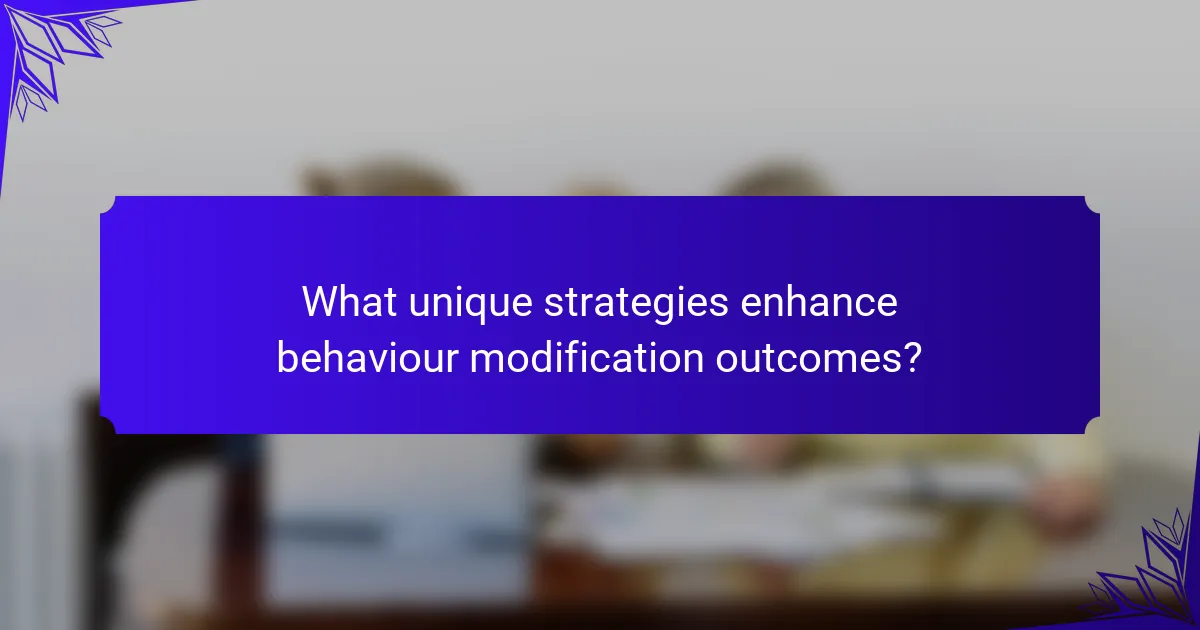
What unique strategies enhance behaviour modification outcomes?
Behaviour modification outcomes can be enhanced through unique strategies such as positive reinforcement, goal setting, and self-monitoring. Positive reinforcement encourages desired behaviours by providing rewards, while goal setting creates clear targets for achievement. Self-monitoring increases awareness of behaviours, promoting accountability and adjustment. These strategies facilitate learning and adaptation, fostering personal growth.
How can mindfulness techniques be integrated into behaviour modification?
Mindfulness techniques can enhance behaviour modification by fostering self-awareness and emotional regulation. Techniques such as meditation and deep breathing promote focus, helping individuals recognize triggers and patterns in their behaviour. This awareness can lead to more intentional responses rather than automatic reactions. Integrating mindfulness into behaviour modification can improve resilience and adaptability, making personal growth more achievable. Regular practice can also reduce stress, further supporting positive behavioural changes.
What innovative technologies are influencing behaviour change?
Innovative technologies significantly influence behaviour change through personalized interventions. Mobile apps utilize data analytics to tailor strategies for individuals, enhancing motivation and adherence. Wearable devices track physiological responses, promoting awareness and encouraging positive habits. Virtual reality immerses users in experiences that foster empathy and alter perceptions. Artificial intelligence analyzes behavioural patterns, providing insights for effective modification techniques. These advancements facilitate continuous learning, adaptation, and personal growth.
How do personalized behaviour modification plans differ from standard approaches?
Personalized behaviour modification plans tailor strategies to individual needs, unlike standard approaches which apply a one-size-fits-all method. Personalized plans consider unique attributes such as personal motivation, specific challenges, and behavioural patterns. As a result, they often lead to more effective adaptation and personal growth. Standard approaches may overlook these nuances, reducing their overall effectiveness.

What rare attributes make certain techniques stand out?
Certain behaviour modification techniques stand out due to their unique attributes. These rare attributes include adaptability to individual learning styles, integration of emotional intelligence, and the ability to foster intrinsic motivation. Techniques that personalize strategies for each individual demonstrate a significant impact on long-term behaviour change. Additionally, methods incorporating mindfulness can enhance self-awareness, making them particularly effective in personal growth contexts.
What are the benefits of using gamification in behaviour modification?
Gamification enhances behaviour modification by increasing engagement, motivation, and retention. It leverages game-like elements to create a rewarding experience, fostering positive habits. By providing immediate feedback and a sense of achievement, users are more likely to adapt their behaviours. Gamification also encourages social interaction, which can further reinforce desired changes.
How does cultural context affect behaviour modification strategies?
Cultural context significantly influences behaviour modification strategies by shaping perceptions, motivations, and responses. Different cultures prioritize various values, which affects how individuals react to rewards or consequences. For instance, collectivist cultures may respond better to group-based incentives, while individualistic cultures may favour personal achievements. Understanding these nuances enhances the effectiveness of behaviour modification techniques, ensuring they align with cultural norms and expectations. Tailoring strategies to cultural contexts fosters better engagement and promotes sustained behavioural change.
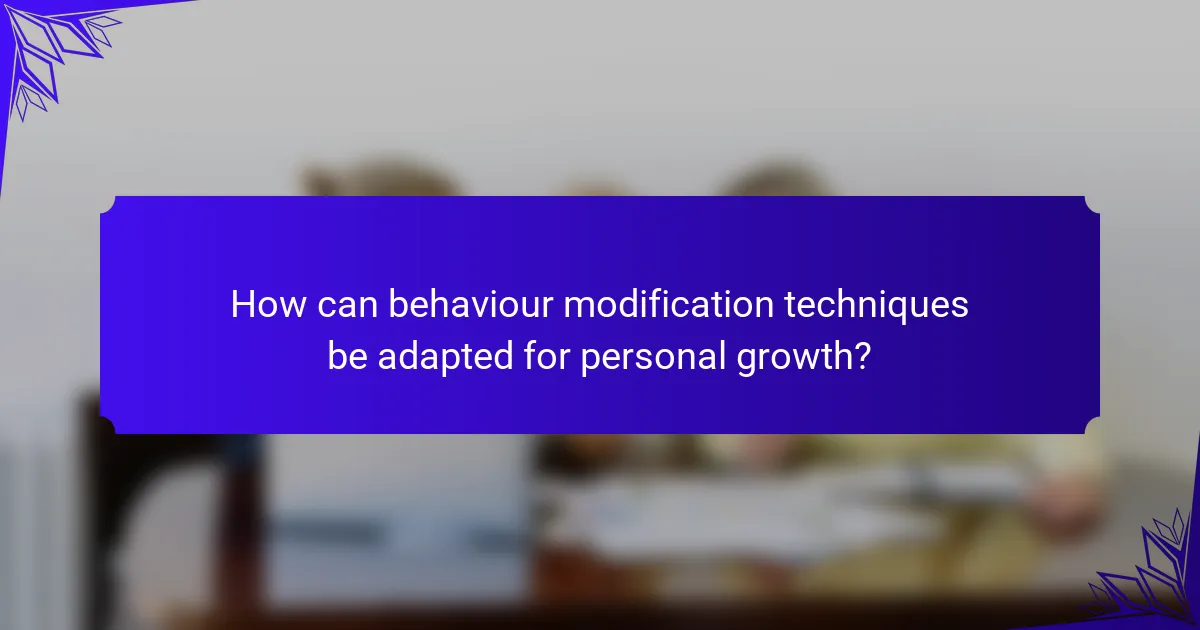
How can behaviour modification techniques be adapted for personal growth?
Behaviour modification techniques can be adapted for personal growth by incorporating self-awareness, goal setting, and reinforcement strategies. These techniques enhance learning and adaptation by fostering positive behavioural changes. For example, using positive reinforcement can motivate individuals to achieve personal goals, while self-monitoring encourages accountability. Additionally, cognitive restructuring can help reshape negative thought patterns, promoting a growth mindset. Engaging in these strategies leads to sustained personal development and improved overall well-being.
What are the steps to create a personal behaviour modification plan?
To create a personal behaviour modification plan, follow these steps: identify specific behaviours to change, set measurable goals, develop strategies for change, implement the plan, and evaluate progress regularly.
1. Identify specific behaviours to change.
2. Set measurable goals for behaviour modification.
3. Develop strategies for change, such as reinforcement and self-monitoring.
4. Implement the behaviour modification plan consistently.
5. Evaluate progress and adjust strategies as needed.
How do you identify target behaviours for modification?
To identify target behaviours for modification, observe and analyze specific actions that require change. Focus on behaviours that impact personal growth and learning. Use methods like self-monitoring, feedback, and goal setting to clarify which behaviours to target. Define clear, measurable objectives to track progress effectively.
What methods can be used to track progress effectively?
To track progress effectively in behaviour modification, use methods such as goal setting, self-monitoring, feedback loops, and accountability partnerships. These strategies enhance learning and personal growth.
Goal setting involves defining clear, measurable objectives to guide behaviour changes. Self-monitoring requires individuals to record their actions and reflect on their progress, fostering awareness. Feedback loops provide timely information on performance, enabling adjustments. Accountability partnerships involve sharing goals with others to increase commitment and motivation.
What common mistakes should be avoided in behaviour modification?
To avoid common mistakes in behaviour modification, focus on clear goals, consistency, and appropriate reinforcement. Setting vague or unrealistic goals can hinder progress. Inconsistency in applying techniques leads to confusion and ineffective outcomes. Additionally, using inappropriate rewards may undermine motivation. Regularly assessing progress is essential for making necessary adjustments.
What expert tips can enhance the effectiveness of behaviour modification strategies?
Utilizing expert tips can significantly enhance behaviour modification strategies. Focus on setting specific, measurable goals to track progress effectively. Employ positive reinforcement to encourage desired behaviours, making them more likely to be repeated. Additionally, incorporate consistent feedback to help individuals understand the impact of their actions. Create a supportive environment that minimizes distractions and promotes focus, which can lead to better outcomes. Finally, tailor strategies to individual needs, as personalization can improve engagement and success rates.
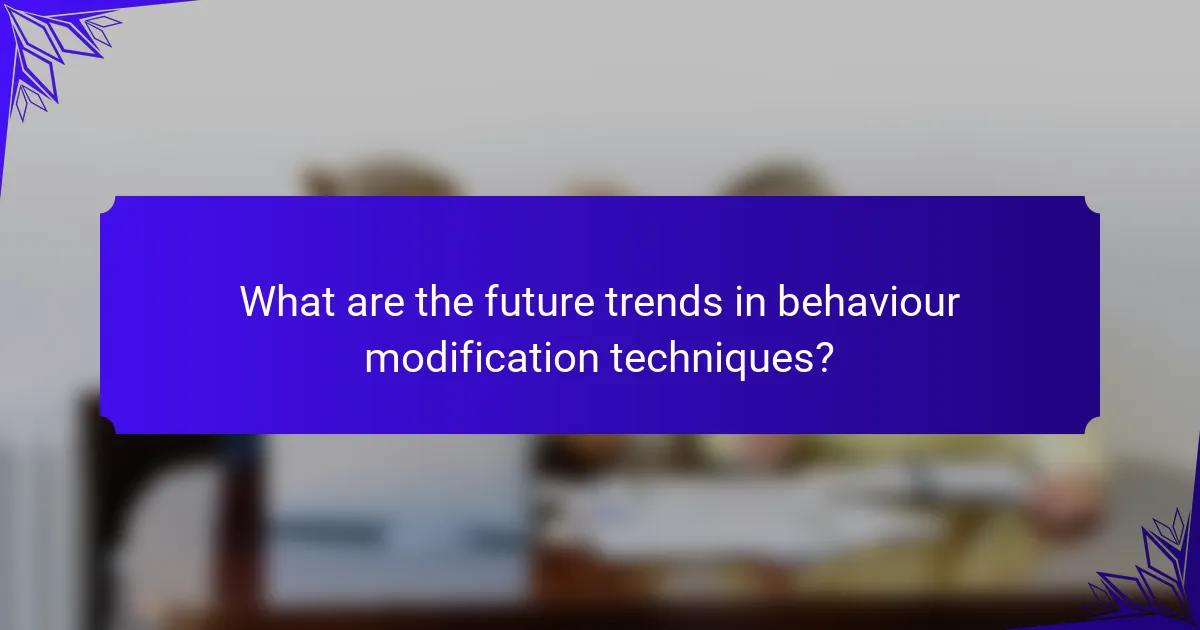
What are the future trends in behaviour modification techniques?
Behaviour modification techniques are evolving towards more personalized and technology-driven approaches. Key trends include the use of artificial intelligence to tailor interventions, the integration of wearable technology for real-time feedback, and an increased focus on mental health and emotional regulation. These advancements enhance the effectiveness and accessibility of behaviour modification strategies, supporting learning, adaptation, and personal growth.
What changes are expected in behaviour modification practices by 2025?
By 2025, behaviour modification practices are expected to integrate advanced technology, personalized approaches, and data-driven insights. Emerging techniques will leverage artificial intelligence to tailor interventions based on individual progress and preferences. Additionally, the incorporation of virtual reality will enhance experiential learning, making behaviour change more engaging and effective. The focus will shift towards holistic strategies that address emotional and psychological factors, promoting sustainable personal growth. As a result, practitioners will utilize a broader spectrum of tools, fostering adaptability in diverse learning environments.
